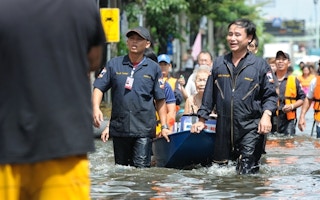Governments set targets to substantially reduce deaths and economic losses from disasters at a UN conference in Japan on Wednesday, but critics were disappointed by the lack of a firm commitment to ramp up financial support for poor countries.
The non-binding agreement, adopted after a marathon negotiating session, includes seven targets to measure progress on protecting people and assets that experts described as a leap forward.
The Sendai Framework for Disaster Risk Reduction, a 15-year plan, replaces the current 10-year blueprint.
In the decade covered by the expiring Hyogo Framework for Action, more than 700,000 people lost their lives, and over 1.5 billion people were affected by disasters. Total economic losses topped $1.3 trillion.
“This new framework… opens a major new chapter in sustainable development as it outlines clear targets and priorities for action which will lead to a substantial reduction of disaster risk and losses in lives, livelihoods and health,” said Margareta Wahlström, head of the U.N. Office for Disaster Risk Reduction (UNISDR).
Implementing the plan “will be vital to the achievement of future agreements on sustainable development goals and climate later this year”, she added.
Some were disappointed that earlier proposals for percentage goals were rejected.
“
This new framework… opens a major new chapter in sustainable development as it outlines clear targets and priorities for action which will lead to a substantial reduction of disaster risk and losses in lives, livelihoods and health.
Margareta Wahlström, head of the UN Office for Disaster Risk Reduction
Instead the draft text includes aims to lower the global mortality rate from disasters between 2020 and 2030, compared to 2005 to 2015, and reduce the proportion of people affected.
Another target is to reduce economic losses in relation to global GDP by 2030.
The new agreement also includes targets to reduce damage to infrastructure and disruption to basic services, including health and education facilities, and to widen access to early warning systems and disaster risk information for the public.
But some disaster experts said a lack of a clear goal in the agreement to increase international aid for risk reduction would undermine developing countries’ efforts to make progress on the goals.
Only Japan put money on the table in Sendai, promising to provide $4 billion in support over the next four years.
“Rich nations have pushed making financial commitments to reduce disaster risk to a separate round of financing negotiations later in the year,” said Farah Kabir, country director of ActionAid Bangladesh, referring to a conference in Ethiopia in July.
Without larger pledges, “the results for vulnerable communities in poor countries will be catastrophic,” he added.
Wahlström told reporters disaster risk reduction had received very little international funding so far, but she was convinced donors would make it a policy priority in coming decades for their development assistance.
Japan’s Minister of State for Disaster Management Eriko Yamatani said that for her government, it was “not really a cost but an investment for the future”.
Help for most vulnerable
The devastation caused by Cyclone Pam in the South Pacific island nation of Vanuatu at the start of the conference last week highlighted the need for greater efforts to protect those most at risk from extreme weather and other hazards.
“Disasters, many of which are exacerbated by climate change and (are) increasing in frequency and intensity, significantly impede progress towards sustainable development,” the Sendai framework said.
“It is urgent and critical to anticipate, plan for and reduce disaster risk in order to more effectively protect persons, communities and countries… and thus strengthen their resilience,” it added.
Maggie Ibrahim of World Vision UK said the Sendai conference had put issues affecting the disabled, women and children in disasters under the spotlight.
But the agreement would not equip them and other vulnerable people with the resources and tools to build skills so they can better prepare for disasters and avert crises, she said.
UNISDR’s Wahlström said the Sendai framework aimed to support local governments to act as first responders in emergencies, and enable citizens to shape disaster risk policies and put them into practice.
Another new element was the prominent inclusion of health, she added, from safeguarding hospitals and providing medical care in disasters, to preventing epidemics and pandemics.
“Health systems have a very strong role to play to ensure… that people and communities are resilient,” she said.










